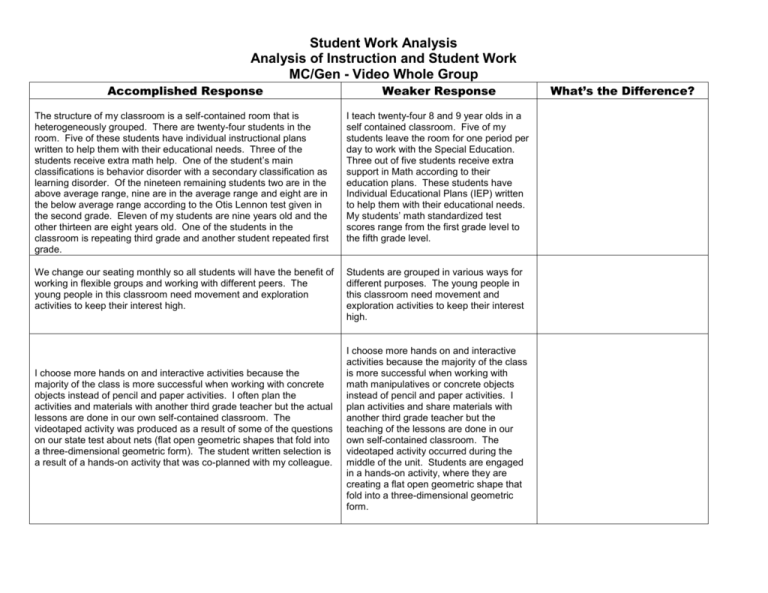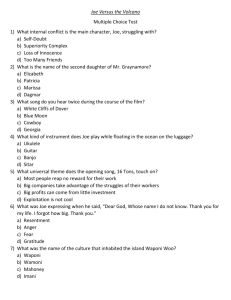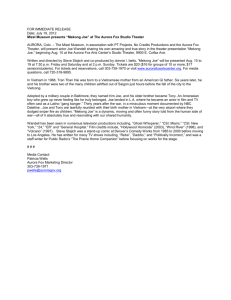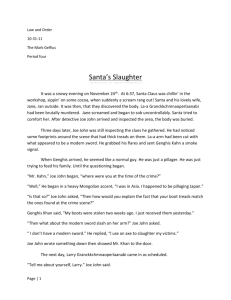Student Work Analysis
advertisement

Student Work Analysis Analysis of Instruction and Student Work MC/Gen - Video Whole Group Accomplished Response Weaker Response The structure of my classroom is a self-contained room that is heterogeneously grouped. There are twenty-four students in the room. Five of these students have individual instructional plans written to help them with their educational needs. Three of the students receive extra math help. One of the student’s main classifications is behavior disorder with a secondary classification as learning disorder. Of the nineteen remaining students two are in the above average range, nine are in the average range and eight are in the below average range according to the Otis Lennon test given in the second grade. Eleven of my students are nine years old and the other thirteen are eight years old. One of the students in the classroom is repeating third grade and another student repeated first grade. I teach twenty-four 8 and 9 year olds in a self contained classroom. Five of my students leave the room for one period per day to work with the Special Education. Three out of five students receive extra support in Math according to their education plans. These students have Individual Educational Plans (IEP) written to help them with their educational needs. My students’ math standardized test scores range from the first grade level to the fifth grade level. We change our seating monthly so all students will have the benefit of working in flexible groups and working with different peers. The young people in this classroom need movement and exploration activities to keep their interest high. Students are grouped in various ways for different purposes. The young people in this classroom need movement and exploration activities to keep their interest high. I choose more hands on and interactive activities because the majority of the class is more successful when working with concrete objects instead of pencil and paper activities. I often plan the activities and materials with another third grade teacher but the actual lessons are done in our own self-contained classroom. The videotaped activity was produced as a result of some of the questions on our state test about nets (flat open geometric shapes that fold into a three-dimensional geometric form). The student written selection is a result of a hands-on activity that was co-planned with my colleague. I choose more hands on and interactive activities because the majority of the class is more successful when working with math manipulatives or concrete objects instead of pencil and paper activities. I plan activities and share materials with another third grade teacher but the teaching of the lessons are done in our own self-contained classroom. The videotaped activity occurred during the middle of the unit. Students are engaged in a hands-on activity, where they are creating a flat open geometric shape that fold into a three-dimensional geometric form. What’s the Difference? Student Work Analysis Analysis of Instruction and Student Work EAYA/WLOE Cultural competence/ Entry 2 (video) Accomplished Response Weaker Response There were many opportunities for students to expand their awareness of their own culture, other cultures represented in the classroom, and the target language culture. I used the paired interview as a starting point for students to reflect on personal traditions and to begin to differentiate between new and familiar. After we discussed and listed general American habits, I had students create Venn diagrams to compare and contrast American and French cultural habits. I used the strategy of a diagram because it helps visual learners to organize their thoughts and ideas. There were many opportunities for students to expand their awareness of their own culture, other cultures represented in the classroom, and the target language culture. I used the paired interview. After we discussed and listed general American habits, I had students create Venn diagrams. On our staff we are lucky to have a native French speaker, originally from Paris. She is a resource for our French curriculum. I invited her to speak to my classes and to answer their questions about traditions surrounding food and eating. I did this because it is good for students to hear more speakers of the target language than just myself, to provide a real-life “source” for the answers to some of our questions, and also to show students that there are French speakers just about everywhere, so the study of French is beneficial. We followed this experience by sampling French foods in the classroom. I purchased traditional French foods (bread, Brie cheese, apin au chocolat pastries) so that my students could taste them for the first time and could compare them with foods in their own and American cultures. Using a motivational grant made available through my school, I was able to take 28 students to have lunch at a French restaurant. I did this to give my students a real-life experience where they could use language they had learned and practiced in the classroom in an unstructured event, and achieve expected or unexpected results, depending on their skills with French. For example, Javier was excited to have more French bread, so when the waiter did not bring any right away, he started to ask, using phrases we practiced. Also, Erik was able to order another “coca” cola in French, without any help, and Jorge asked for a replacement fork after he dropped his. On our staff we are lucky to have a native French speaker, originally from Paris. She is a resource for our French curriculum. I invited her to speak to my classes and to answer their questions about traditions surrounding food and eating. We followed this experience by sampling French foods in the classroom. Using a motivational grant made available through my school, I was able to take 28 students to have lunch at a French restaurant. What’s the Difference? Student Work Analysis Analysis of Instruction and Student Work – ECYA/ENS, Fostering Communications Development Accomplished Response Weaker Response This school year, picture symbol communication has been a secondary goal for Joe. Because Joe tends to develop his own ways of communicating the things that are important to him, no one has ever encouraged him to use picture symbols. However, there are several reasons why I think it is important to begin doing so. The primary reason is that Joe is approaching graduation and transition to adult vocational settings. Even though we understand his vocalizations and gestures, people outside of school and family won’t understand much of what he says. Picture symbols would be universally understood. This school year, picture symbol communication has been a secondary goal for Joe. No one has ever encouraged him to use picture symbols before now. However, there are several reasons why I think it is important to begin doing so. The primary reason is that Joe is approaching graduation and transition to adult vocational settings. Even with Joe’s serious cognitive delays, he initiates communication with people and shows frustration when he is not understood. Taking away what little communication that he has would be devastating to him, so we need to find a way for him to successfully communicate with people who aren’t familiar with his patterns. Attention to visual detail and visual discrimination are relative strengths for Joe, and he has already demonstrated the ability to match photographs to concrete objects. Therefore, the next logical step is to teach him to match picture symbols to concrete objects. Even with Joe’s serious cognitive delays, he initiates communication with people and gets upset when people don’t understand him. He can already match pictures to objects, so picture symbols should be easy for him to learn. From there, I hope to teach Joe the more abstract concept that symbols can stand for messages. I have collaborated with Joe’s family and several community sources to secure funding for a sixteen square augmentative communication device. Joe should receive the device sometime this summer and I plan to spend some time with his family teaching them how to program and use it. Hopefully, he will be able to competently use the device by the time he goes to a vocational setting in the fall. If he learns to use the symbols, he can also use the communication device that I am getting for him. What’s the Difference?











